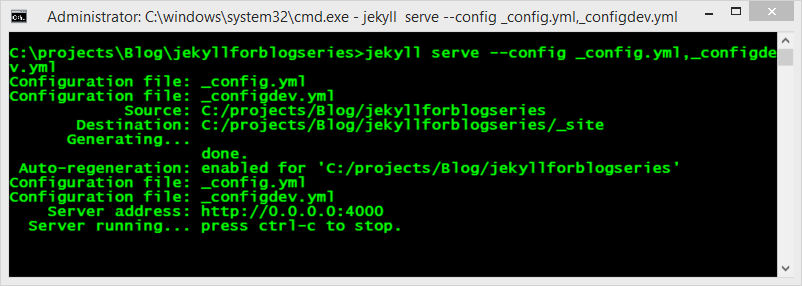Welcome the continuing series on using Jekyll. In this tutorial we are going to setup your Ubuntu Linux computer to be able to edit your blog on your computer.
Overview
Up to this point we have been using the Github web site to edit all of our files but the downside to this is that any chances you want to make show up live in your blog before you have had a chance to test them.
Instead, it is better if you can test out all of your changes and review your blog post before letting the world see them. It will also let you have draft post where you can see them locally but on github they will not be visible.
Section 1: installing Software
We need to install nodejs, ruby 2.x, python pip, and git.
Section 1.1: Installing NodeJs
First we are going to install NodeJS using the command below
# Note the new setup script name for Node.js v0.12
curl -sL https://deb.nodesource.com/setup_0.12 | sudo bash -
# Then install with:
sudo apt-get install -y nodejs
node -v
Section 1.2: Installing Ruby
Ubuntu Trusty 14.04 unfortunately comes with Ruby 1.9.x and we need 2.x. There is also a bug in the ubuntu packages where the Ruby 2.0 install is actually the 1.9.3 branch.
We are going to use ruby-install to get the latest version of Ruby installed
wget -O ruby-install-0.5.0.tar.gz https://github.com/postmodern/ruby-install/archive/v0.5.0.tar.gz tar -xzvf ruby-install-0.5.0.tar.gz cd ruby-install-0.5.0/ sudo make install sudo ruby-install --system rubyWe need to install chruby to change the ruby version to the one that we just installed
wget -O chruby-0.3.9.tar.gz https://github.com/postmodern/chruby/archive/v0.3.9.tar.gz tar -xzvf chruby-0.3.9.tar.gz cd chruby-0.3.9/ sudo make installTo make chruby auto run we need to add the following lines to our ~/.bashrc or ~/.bash_profile script
source /usr/local/share/chruby/chruby.sh source /usr/local/share/chruby/auto.shIn order to it to take effect run replace .bashrc with .bash_profile if you are using that instead
source ~/.bashrcVerify your ruby version changed with
ruby -vMake sure that the Ruby Gems are updated and then install the bundler GEM
sudo gem update --system sudo gem install bundler
Section 1.3: Python
In order to use the Pygments code syntax highlighter, we need to install python pip
sudo apt-get install python-pip -y
Section 1.4: Installing Git
sudo apt-get install git -y
Section 2: Getting your Blog onto your computer
In this section, you will clone the blog repo from github and install jekyll.
Open a terminal
Create the directory ~/projects
mkdir ~/projectscd into c:\projects
cd ~/projectsClone your github blog repo to your local machine with the “git clone [Repo Name]” command. Below is the example if you were to clone the jekyll repo for this blog series.
git clone https://github.com/digitaldrummerj/jekyllforblogseries.gitcd into the repo that you just cloned
cd jekyllforblogseriesMake sure that you have a GemFile with no file extension in the root of your repo with the following contents
source 'https://rubygems.org' gem 'github-pages' gem 'jekyll-redirect-from'Run the command to install the github-pages gem which has all of the required modules to make jekyll work and the jekyll redirect from plugin. It is one of the few plugins that Github pages supports and allows you to move pages around and have them automatically redirect so that people with bookmarks can still find a moved page.
bundle install
Now we have jekyll installed. Time to test it out
Section 3: Testing Your Blog Works on Your Computer
Now that we have everything installed for jekyll it is time to test it out.
From a command prompt in your blog repo directory run the following command to tell jekyll to build and run the web site locally
jekyll serveIf it build successfully you will see something like this

Now if you open up your browser and navigate to http://localhost:4000 you will see you blog.
However, by default your _config.yml file will be set for production which will cause any place that you have referenced the site.url to not working on your local machine. You don’t want to change your _config.yml file though for development since you will accidentally check it in at some point and break your blog. Instead we can tell jekyll to use multiple configuration files. When you load multiple files it will load them in order and then override any settings from a previously loaded config.
Create a new file in the root of your repo called _configdev.yml
In the _configdev.yml add the following lines to set the url, turn off disqus/google analytics and google search.
# then add this to the url as well "/repository-name" url: http://localhost:4000 disqus: disquscommentcount: google_analytics: google_search:If your jekyll serve is still running do a ctrl+c to stop it.
Now run the following command to tell jekyll the config yml files to load
jekyll serve --config _config.yml,_configdev.ymlIf it build successfully you will see something like this

Now if you open up your browser and navigate to http://localhost:4000 you will see you blog and any place that reference site.url will be working.
Conclusion
Now you are ready to do all of your editing locally and test it out before the world gets to see it.
In our next lesson, I will show you how to install jekyll on OSx. Then you will learn how to create draft blog post that will only show on your local machine so that you don’t have to either clutter up your post directory with drafts or worry about accidentally publishing an unfinished article.